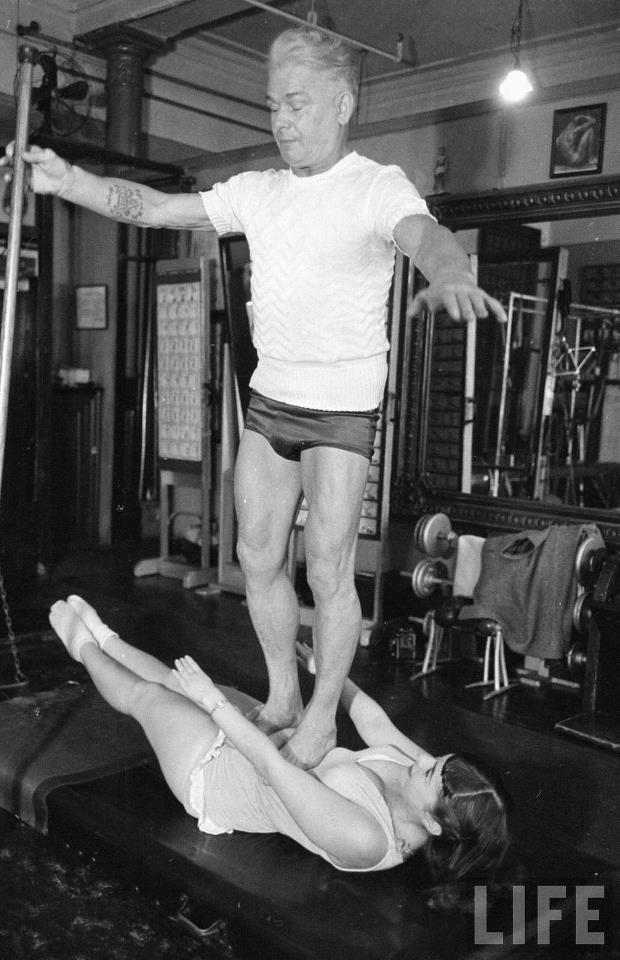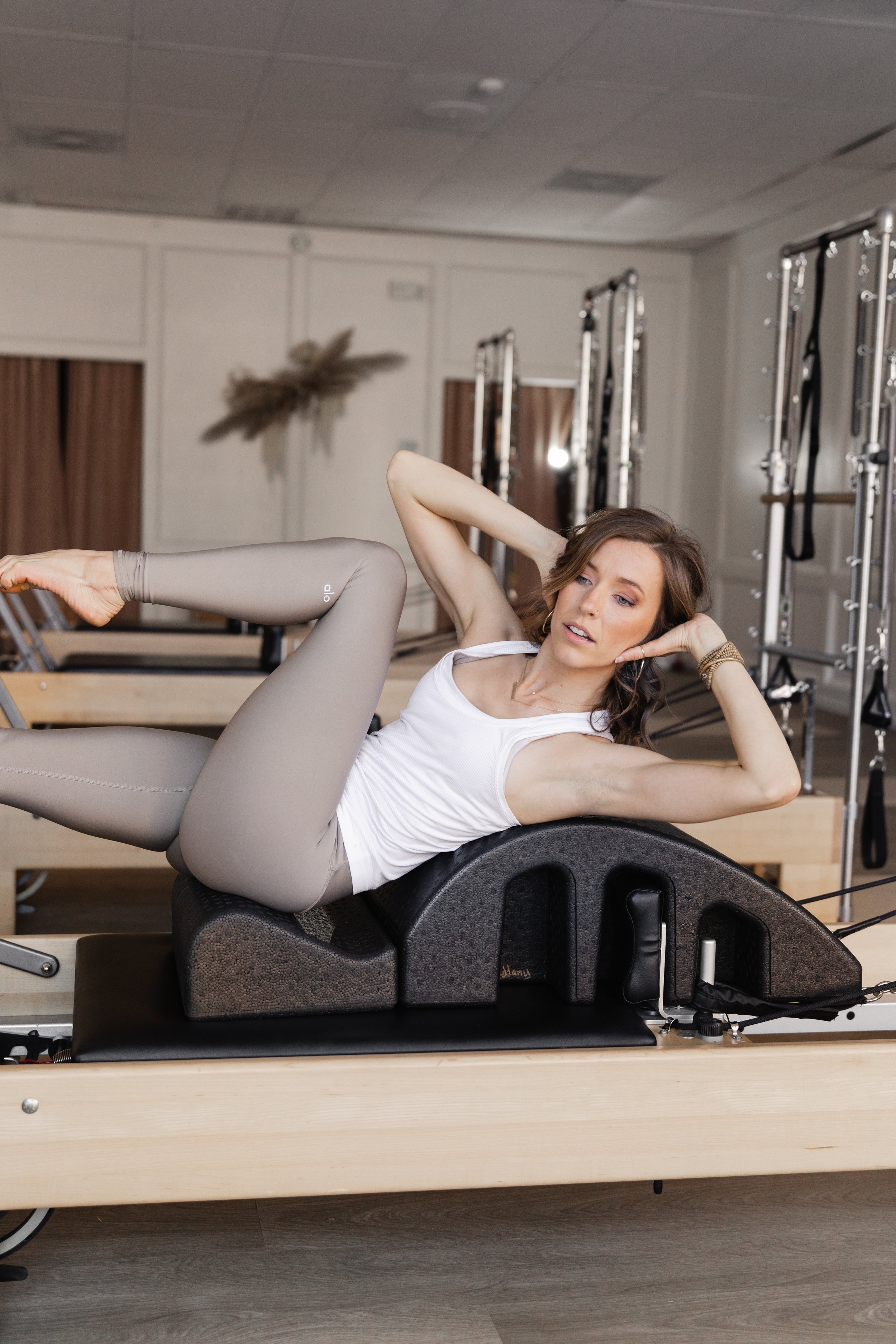What is Pilates?
The Pilates Method is a versatile form of exercise intricately designed to increase strength, improve posture, and encourage a mind body relationship. This gentle, but challenging, modality presents an alignment based focus, and offers stability, mobility, and balance in the body while lengthening and toning muscles.
How it all began…
Joseph Hubertus Pilates was born in Monchengladbach Germany in 1883. As a child, Joe had asthma and other ailments. He turned to exercise and athletics to battle these ailments and was always studying various exercise regimens to expand his knowledge base. He became enamored by the classical Greek ideal of a man balanced in body, mind, and spirit, and he began to develop his own exercise system based on this concept.
Growing into adulthood, Joe was no longer the sickly child he had once been as he became an avid skier, diver, gymnast, and boxer.
In 1912 Joe went to England, where he worked as a self-defense instructor for detectives at Scotland Yard. At the outbreak of World War I, Joe was interned as an “enemy alien” with other German nationals. During his internment, Joe refined his ideas and trained other internees in his system of exercise. He rigged springs to hospital beds, enabling bedridden patients to exercise against resistance, an innovation that led to his later equipment designs. An influenza epidemic struck England in 1918, killing thousands of people, but not a single one of Joe’s trainees died. This, he claimed, testified to the effectiveness of his system.
After his release, Joe returned to Germany. His exercise method gained favor in the dance community, primarily through Rudolf von Laban, who created the form of dance notation most widely used today. Hanya Holm adopted many of Joe’s exercises for her modern dance curriculum, and they are still part of the “Holm Technique.” When German officials asked Joe to teach his fitness system to the army, he decided to leave Germany for good.
Pilates comes to the U.S.
In 1926, Joe emigrated to the United States. During the voyage he met Clara Zeuner, whom he later married (many people don’t know that Clara was Joe’s third wife). Joe and Clara opened a fitness studio in New York, sharing an address with the New York City Ballet.
By the early 1960s, Joe and Clara could count among their clients many New York dancers. George Balanchine studied “at Joe’s,” as he called it, and also invited Pilates to instruct his young ballerinas at the New York City Ballet.
Pilates was becoming popular outside of New York as well. As the New York Herald Tribune noted in 1964: “in dance classes around the United States, hundreds of young students limber up daily with an exercise they know as ‘a pilates’, without knowing that the word has a capital P, and a living, right-breathing namesake.”
His students begin to teach
While Joe was still alive, two of his students, Carola Trier and Bob Seed, opened their own studios. Trier, a dancer, found her way to the United States by becoming a performing contortionist after fleeing a Nazi holding camp in France. She found Joe Pilates in 1940, when a non-stage injury pre-empted her performing career. Joe Pilates assisted Trier in opening her own studio in the late 1950s. Joe and Clara remained close friends with Trier until their deaths.
Bob Seed was another story. A former hockey player turned Pilates enthusiast, Seed opened a studio across town from Joe and tried to take away some of Joe’s clients by opening very early in the morning. According to John Steel, Joe and Clara’s business manager, one day Joe visited Seed with a gun and warned Seed to get out of town. Seed went.
Joe continued to train clients at his studio until his death in 1967, at the age of 87. When he passed away, he left no will and had designated no line of succession for the Pilates work to carry on.
Nevertheless, his work would remain and eventually flourish in large part due to his protégés, referred to as the “elders.”
The elders
Clara continued to operate what was known as the Pilates Studio on Eighth Avenue in New York. Romana Kryzanowska became the director around 1970. Kryzanowska had studied with Joe and Clara in the early 1940s and then, after a 15-year hiatus spent in Peru, returned to renew her studies.
Pilates Principles
-
"The breath is the essential link between the mind and the body. It draws our wandering mind back into our bodies and back to the task at hand. It is the foundation of our existence and the rhythm that accompanies us from birth to death. In Pilates the breath is integrated into every movement in order to focus our awareness on what we are doing, to improve the flow of oxygen through our bodies and to improve the capacity of our lungs."
-
"To concentrate is to pay attention to what you are doing. To be present with and in control of the task at hand. Without concentration the exercises lose their form and their purpose. When teaching it is important to have a client do only as many repetitions as they can without losing their concentration. As Joe often said, “it is better to do five repetitions perfectly then 20 without paying attention."
-
"To be in control is to understand and maintain the proper form, alignment and effort during an entire exercise. Pilates exercises are never done without engaging the mind to control the movement and the efforts that the body is making."
-
“In Pilates all movement radiates outward from the center. Developing strong, stable and flexible center is one of the defining features of this for of exercise.”
-
"Precision is the ability to perform exercises with optimum alignment, unconscious control and just the right amount of effort. Precision is the end product of concentration, control, centering and practice."
-
"Understanding, developing and maintaining correct alignment and form is essential to Pilates and overtime will lead to balanced muscle development. With practice these principles become second nature and lead to improved posture, increased comfort and enhanced physical abilities."
-
"All movements in Pilates are done with a sense of rhythm and flow. Flow creates smooth, graceful and functional movements. It decreases the amount of stress placed on our joints and develops movement patterns that integrate our body into a smoothly flowing whole."
-
"Pilates is fundamentally about integration: integrating movement into a flowing whole body experience, integrating the mind and body to create clarity and purpose, integrating mind, body and spirit to create a life of balance."
-
“To be healthy in body and mind it is important to understand the balance between effort and relaxation. In Pilates we learn to use just the amount of effort needed to complete the exercise correctly, no more, no less. Learning to release unnecessary tension in our bodies helps us to find ease and flow in Movement and in the rest of our lives.”
Pilates Movement Principles
-
“Breathing is the first movement principle because it is the first thing we do. It is the foundation of our existence and creates the fundamental rhythm that underlies our life. Learning to breathe optimally is essential for health and well being. Breathing techniques can be used to decrease stress, lower or raise blood pressure, improve aerobic capacity and calm mind and spirit. Breathing has been used by every culture to change mind and body states in meditation, exercise and daily living.”
-
The lower core, or powerhouse, is the foundation of every exercise in Pilates and in life.
Transversus abdominus
Pelvic floor
Multifidi, Diaphragm
Anterior fibers of psoas major
Quadratus Lumborum
These systems work together to stabilize the pelvis and lumbar spine when stress is placed on them as in lifting, bending, sitting, sitting, twisting, walking, running or jumping.
-
“According to current research in biomechanics, the core or “inner unit” works best as a spinal stabilizer when the pelvis is in a neutral position. The placement of the pelvis is considered to be neutral when the anterior superior iliac spines and the pubic bone are in a plane perpendicular to the ground in standing or sitting, and parallel to the ground when supine. Finding the right starting position for each exercise provides a solid foundation to move from and creates more comfortable and efficient movement patterns.”
-
“Abdominal strength starts with the core but the core does not move the torso. In order to create movement the remaining abdominals must be engaged.
Internal oblique abdominal
External oblique abdominal
Rectus Abdominus
-
“Lumbopelvic stability is related to core and abdominal strength but it includes all of the muscles that attach to the pelvis and the spine through the action of the four outer units
Anterior oblique sling
Posterior oblique system
Deep longitudinal system
Lateral system
All of the outer unit play some role in virtually every Pilates exercise and in functional movement. Maintaining balance and strength in the four outer units is essential for preventing low back dysfunctions and for creating efficient and graceful movement patterns.”
-
“Another Pilates principle involves optimizing the mobility of the torso in all directions. Any activity that we engage in, from walking to swimming to playing tennis to driving our cars, involves movement in the spine. If the spine loses mobility in a certain direction, movement will be less comfortable and pain and injury can be the result.”
-
“The shoulder area is one of the most anatomically complex areas of the body and one that is prone to injury and dysfunction. Learning to work with this area successfully can make a tremendous difference in how you look, feel and perform.
Three primary bones:
Clavicle, scapula and humerus
Three primary joints:
Sternoclavicular, acromioclavicular and glenohumeral joints
In humans the shoulder is designed for maximum mobility so we can get our arms over our heads and hang from our hands. This mobility creates challenges in circumstances where stability is required for the safety of the joints as when we are lifting heavy weight over our head or reaching behind us to pick something up. The stability of the joints is created primarily by the muscles that support them.”
-
“Postural analysis is the science of understanding the optimum relationship of the body to gravity in order to create good posture and efficient movement patters. When the bony landmarks are lined up correctly, the body uses less energy to hold itself up.”
-
“An addition to the traditional Pilates work, here is a series of exercises designed to release and relax certain chronically tight parts of the body including the neck and shoulders and the low back and hips. When an area is tight, it can limit the range of motion in an associated joint and keep the muscles in the area from working in proper sequence.”
-
“Pilates mat work, all by itself, will help to stretch several chronically tight areas of the body, particularly the hamstrings, low back, shoulders and hips. Specific stretching exercises can speed up the body’s ability to change and to learn new movement patterns.”
Three types of stretches
Contract/Release
Active isolated Stretch
Static Stretching
All Principles take from Balanced Body Manuals








